The Shepherd's Rod vol. 2
THE PROPHECY OF DANIEL AND THE REVELATION OF JOHN CONTAINS THE WORLD’S HISTORY
THE PROPHECY OF DANIEL AND THE REVELATION OF JOHN CONTAINS THE WORLD’S HISTORY
"Blessed is he that readeth, and they that hear the words of this prophecy, and keep those things which are written therein: for the time is at hand." (Rev. 1:3.)
"Let none think, because they cannot expound the meaning of every symbol in the Revelation, that it is useless for them to search this book in an effort to know the meaning of the truth it contains. The one who revealed these mysteries to John will give to the diligent searcher for truth a foretaste of heavenly things. Those whose hearts are open to the reception of truth will be enabled to understand its teachings, and will be granted the blessing promised to those who 'hear the words of this prophecy, and keep those things which are written therein'. " -- "The Acts of the Apostles," p. 584.
"In the Revelation all the books of the Bible meet and end. Here is the complement of the book of Daniel. One is a prophecy; the other a revelation. The book that was sealed is not the Revelation, but that portion of the prophecy of Daniel relating to the last days. The angel commanded, 'But thou, O Daniel, shut up the words, and seal the book, even to the time of the end'." -- Id. p. 585.
"The number seven indicates completeness.... while the symbols used reveal the condition of the church at different periods in the history of the world." -- Id. p. 585.
"Finite men should beware of seeking to control their fellow men, taking the place assigned to the Holy Spirit. Let not men feel that it is their prerogative to give to the world what they suppose to be truth, and refuse that anything should be given contrary to their ideas. This is not their work. Many things will appear distinctly as truth, which will not be acceptable to those who think their own interpretation of the Scriptures always right. Most decided changes will have to be made in regard to ideas which some have accepted as without a flaw." -- "Testimonies to Ministers," p. 76.
A large portion of Christendom agree that we are living in the last days of this world's history. When Jesus was asked by his disciples for the signs of His return to earth again, and of the end of the world, one of the many signs He gave was; "When ye therefore shall see the abomination of desolation, spoken of by Daniel the prophet, stand in the holy place, (whoso
Shepherd's Rod book, Vol. 2 27
readeth, let him understand:)." (Matthew 24:15.) It is evident from the words of the Master that the book of Daniel contains information regarding the signs of the times and of the end of the world. The prophecies of Daniel were of little worth to the disciples and the early Christian church, for Daniel says the book was sealed to the time of the end. (Dan. 12:4.) And since the book is now open it is evident that we are living in the time of the end. (Rev. 22:6-10.) But the book was to be open to one class of people and shut to another, for He added, "Many shall be purified and made white, and tried; but the wicked shall do wickedly: and none of the wicked shall understand; but the wise shall understand." (Dan. 12:10.) Therefore, it is important that we should be free from all wickedness and obedient to the divine requirements, if we would understand and receive the blessings contained in the book.
The intention of this publication is not to explain the symbols which have heretofore been fully explained in various publications and proved to be correct in general outline up to the present, but our intention is to clear certain features which have been hidden by the Spirit of God for a time. The outstanding symbols which are so familiar to Bible students, will be briefly visualized, sufficient only to connect the thought with the symbols that are to be explained. We shall endeavor to prove that the symbols of the book of Daniel and Revelation contain the entire world's history, both civil and religious, from creation to redemption.
In the second chapter of Daniel, beginning with the first universal kingdom (Babylon) after the flood, we have the world's history from thence to the second coming of Christ, or to the end of the present world, represented in one great metalic image. "Thou, O king, sawest, and behold a great image. This great image, whose brightness was excellent, stood before thee; and the form thereof was terrible. This image's head was of fine gold, his breast and his arms of silver, and his thighs of brass, his legs of iron, his feet part of iron and part of clay. Thou sawest till a stone was cut out without hands, which smote the image upon his feet that were of iron and clay, and brake them to pieces.... And in the days of these kings shall the God of heaven set up a kingdom, which shall never be destroyed: and the kingdom shall not be left to other people, but it shall break in pieces and consume all these kingdoms, and it shall stand forever. Forasmuch as thou sawest that stone was cut out of the mountain without hands, and that it brake in pieces the iron, the brass, the clay, the silver, and the gold: the great God hath made known to the king what shall come to pass
Shepherd's Rod book, Vol. 2
28
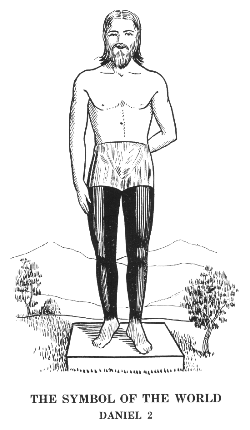
|
Shepherd's Rod book, Vol. 2 29
hereafter: and the dream is certain, and the interpretation thereof sure." (Dan. 2:31-34, 44, 45.)
The gold, silver, brass, and iron have been interpreted to represent Babylon, Medo-Persia, Grecia and Rome. The mixture of iron and clay -- the feet and the toes -- the present kingdoms succeeding the fall of Rome. Wonderful prophecy it is, so simple and so true. But this great image only reveals the framework, as it were, of our world's history.
In the seventh chapter of Daniel we have the same chronological arrangement in symbols of various beasts. The reason for the duplication is to reveal in detail the historical events which were to transpire within the framework of the great image. "Daniel spake and said, I saw in my vision by night, and, behold, the four winds of the heaven strove upon the great sea. And four beasts came up from the sea, diverse one from another. The first was like a lion, and it had eagle's wings: I beheld till the wings thereof were plucked, and it was lifted up from the earth, and made to stand upon the feet as a man, and a man's heart was given to it. And behold another beast, a second like to a bear, and it raised up itself on one side, and it had three ribs in the mouth of it between the teeth of it: and they said thus unto it, Arise, devour much flesh. After this I beheld, and lo another, like a leopard, which had upon the back of it four wings of a fowl; the beast had also four heads; and dominion was given to it. After this I saw in the night visions, and beheld a fourth beast, dreadful and terrible, and strong exceedingly; and it had great iron teeth: and it devoured and break in pieces, and stamped the residue with the feet of it: and it was diverse from all the beasts that were before it; and it had ten horns. I considered the horns, and, behold there came up among them another little horn, before whom there were three of the first horns plucked up by the roots: and behold, in this horn were eyes like the eyes of a man, and a mouth speaking great things." (Dan. 7:2-8.)
The lion, the bear, the leopard, and the non-descript beast depict the same kingdoms as the gold, the silver, brass and iron. The unnatural and peculiar symbols connected with the beasts, namely, the wings, ribs, horns, and heads, are capable of disclosing the mysteries of historical occurrences which were to transpire within the great prophetic periods. The most wonderful thing about these prophetic symbols is that they are perfectly capable of revealing the truth, and once understood aright, they cannot be contradicted. Any interpretation of symbolical prophecies that do not perfectly fit the explanation given is never to be depended upon. The interpretation of such symbols must not
Shepherd's Rod book, Vol. 2 30
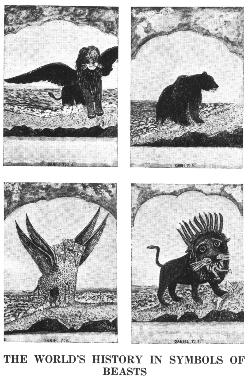
|
Shepherd's Rod book, Vol. 2 31, 32
only be in harmony with the whole tenor of God's book and law, but it must point out some important lesson for God's people; and when such an explanation, as referred to, is derived from the scriptures, then only we have the truth.
While the head of gold on the great image represented the kingdom of Babylon at the height of her glory, the lion covers a greater period according to Genesis 10:8-10: "And Cush begat Nimrod: he began to be a mighty one in the earth. He was a mighty hunter before the Lord: Wherefore it is said, Even as Nimrod the mighty hunter before the Lord. And the beginning of his kingdom was Babel, and Erech, and Accad, and Calneh, in the land of Shinar." The beginning of Nimrod's kingdom was "Babel," or as it is in the Greek, "Babylon." His dominion extended over the four cities of the plain; namely, Babylon, Erech, Accad, and Calneh. If the reader will turn to Genesis 10:1-8 and carefully count the persons born from the family of Noah after going out from the ark of the deluge to the birth of Nimrod, it will be noticed that Nimrod is the 26th person born after the flood. The location of the city was in the land of Shinar, as in Genesis 11:2: "And it came to pass, as they journeyed from the east, that they found a plain in the land of Shinar; and they dwelt there."
The name Babel (Babylon
in Greek) originated at the time the tower of Babel was in building, after
which God confounded the multitude by diversity of speech. According
to Daniel, the capitol of Babylon stood on the same plain: "And the Lord
gave Jehoiakim, king of Judah into his hand [The king of Babylon],... which
he carried into the land of Shinar." (Dan. 1:2.) Therefore Babylon
was founded immediately after the flood, perhaps somewhere between 2400
and 2300 B.C., and had reached her height as a universal empire between
400 or 500 B.C. Babylon, in her development, had consumed a period
of about 1800 years or more. Certainly no one would think that Babylon
made very rapid speed in conquering the ancient world.
Symbol
of Wings and Ribs
We may now inquire the meaning of the wings on the lion and on the leopard; also the ribs in the mouth of the bear. The wings on the lion certainly cannot represent speed, as some have taught. If wings were to represent rapidity they should have been on the bear, for Cyrus and Darius conquered old Babylon over night. Furthermore, if wings represent speed on one beast, they must likewise represent the same on the other. Could they represent speed on the four-headed leopard beast? Certainly not. A careful observation of the symbols
Shepherd's Rod book, Vol. 2 33
show that the leopard beast had nothing to do with Alexander's conquest of Medo-Persia. The leopard represents the kingdom after the conquest was accomplished. The four heads are the four Grecian divisions after the death of Alexander; namely, "Cassander, Lysimachus, Ptolemy, and Seleucus."
The conflict and conquest between Medo-Persia and Grecia is brought to our attention in Daniel 8:5-7: "And as I was considering, behold, an he goat came from the west on the face of the whole earth and touched not the ground: and the goat had a notable horn between his eyes. And he came to the ram which had two horns, which I had seen standing before the river, and ran into him in the fury of his power. And I saw him come close unto the ram, and he was moved with choler against him, and smote the ram, and brake his two horns: and there was no power in the ram to stand before him, but he cast him down to the ground, and stamped upon him: and there was none that could deliver the ram out of his hand."
In Dan. 8:20, 21, Daniel was told by the angel that the he goat "is Grecia," the ram, "Medo-Persia," and the notable horn between his eyes, is "the first king." Therefore, Alexander's swift conquest is represented by the "he goat" which touched not the ground. If wings were to represent speed they should have been on the "he goat" and not on the leopard. Since the truth of what has been said cannot be denied, and as the thought that has been entertained by some is contradictory to the symbols, we must look elsewhere for the application of the "wings." We think it is far safer and wiser as well as more reasonable for one to admit his mistake -- as we mortals are apt to make many of them -- rather than to become involved in contradictory interpretations of the Word of God.
First, we must understand that Inspiration is recording by means of these symbols the entire world's history. Let us not forget that there was a world before the flood. If one of us should undertake this wonderful architectural feat to devise a blue-print, or chart, of this world's history, we certainly would take into consideration a complete account of all its parts. God being infinite in wisdom, as well as in power, would certainly not overlook or thoughtlessly neglect in His great chart of historical events to consider His world before the flood.
A record of a divine survey of this world's history from creation to redemption would be of great importance at this present time. In an age of infidelity, atheism, and hypocrisy, men who profess to be wise in secular, as well as religious matters, have lost sight of the source of true wisdom and knowledge. "Because that, when they knew God, they glorified Him not as God, neither
Shepherd's Rod book, Vol. 2
34
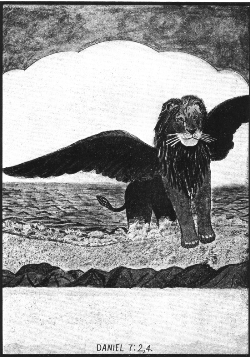
|
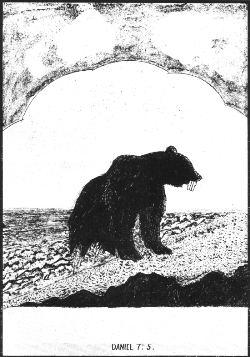
|
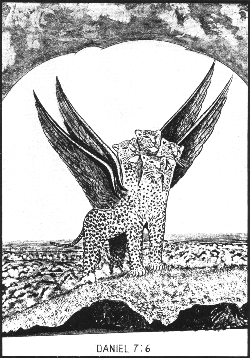
|
were thankful; but became vain in their imaginations, and their foolish heart was darkened. Professing themselves to be wise, they became fools." (Rom. 1:21, 22.) Even those who profess to be teachers of righteousness, have forfeited their faith in the Biblical reckoning of creation. God having knowledge of the present deceptive denial of His holy Word, has devised a prophetic blue-print in symbols of beasts, wings, ribs, horns, heads, crowns, etc., by which He points out in this prophetic panorama, the facts, with a force that should humiliate men and show them their utter ignorance and lack of wisdom.
According to Biblical reckoning the flood came more than 1600 years after creation. God originated the human race through Adam and Eve. Therefore, one people, one race, one language and nation from creation to the flood. The rulership given to Adam we call the first universal Adamic empire. Babylon was the second; Medo-Persia is the third; Grecia the fourth; Rome the fifth; the broken state of Rome (symbolized by the feet and toes of the great image of Daniel 2, which is the present unstable civilization) is the sixth; and from the close of the millennium after the resurrection of the wicked to their second death, is the seventh and last. Thus the Biblical number seven, as always, signifies, completeness. Therefore, seven such universal empires, revealing a complete history of the world, denote the end of sin and its dominion.
If we mortals were to devise such a chart by symbols of beasts, it is certain we would have sufficient intelligence to number every beast in his regular order. We may not suppose that God is less thoughtful in His marvelous perfection. Therefore, He has numbered every beast. We must first consider those which represented the Old Testament time, by the great metallic image; namely, the Gold -- Babylon; the silver -- Medo-Persia; the brass -- Grecia. Gold is the chief of metals which would stand as number one; silver is second to gold, therefore number two; brass is third to gold, meaning number three. The lion, the bear, and the leopard are numbered in like manner. The lion is king or chief of beasts, therefore number one, corresponding with the gold. The bear is second to a lion, therefore number two, corresponding with silver. The leopard is third to a lion, hence number three, corresponding with the brass. These are the first set of numbers, but there is yet another set of which we must speak.
These would bring us back to our subject of what is the meaning of the wings on the lion as well as on the leopard, and the ribs in the mouth of the bear. God certainly would not have mapped out the world's history, from the flood to the end, and
Shepherd's Rod book, Vol. 2 41
failed to take into account all its parts. There must be something in this chart of historical events to indicate that He had a universal empire before the flood, as previously explained. That empire being the first, naturally stands as number one; Babylon number two; Medo-Persia, number three; and Grecia, number four. If this claim is correct, we must find this set of numbers on the lion, bear and leopard.
The wings on the lion denote empire number two. The lion by nature is first -- first from the flood but (unnaturally) by two wings, second from creation. The ribs in the mouth of the bear signify empire number three. The bear by nature is second from the flood, but (unnaturally), by three ribs he is third from creation; ribs are used, for wings go in pairs. The four wings on the leopard denote that Grecia is the fourth universal empire. The leopard by nature is third from the flood, but (unnaturally), by the wings, fourth from creation. History flies, therefore wings make a perfect symbol. “Arise, Devour Much Flesh”
"Arise, devour much flesh," said the ribs to the bear. (Dan. 7:5.) The Medo-Persia opened the way for imperial wars, therefore: "Arise, devour much flesh." Thus empire after empire plunged into bloody wars. The ribs in the mouth of the bear cannot mean nations, as some have taught, for nations are symbolized by horns, and not by ribs. Neither can they denote certain provinces that Medo-Persia could not have conquered, for he has them in his mouth, and it would be inconsistent to suppose that the Persians would have oppressed certain states more than others. Had that been the case, the bear would have stamped upon them as did the non-descript beast. (Dan. 7:7.) The symbol is contrary to such suppositions, and there is neither proof nor lesson that could be derived by any such theory Plucked the Lion’s Wings
Coming back to the lion, symbol of Babylon, Daniel says: "The first was like a lion, and had eagle's wings: I beheld till the wings thereof were plucked, and it was lifted up from the earth, and made to stand upon the feet as a man, and a man's heart was given to it." (Dan. 7:4.) "His wings were plucked." The symbol denotes the same as the plucking of the three horns from the non-descript beast. (Dan. 7:8.) If the plucking up of the horns denotes their kingdom was taken from them, then plucking the wings signifies that Babylon, as empire number two was to pass away, fulfilling Daniel's interpretation of the
Shepherd's Rod book, Vol. 2 42
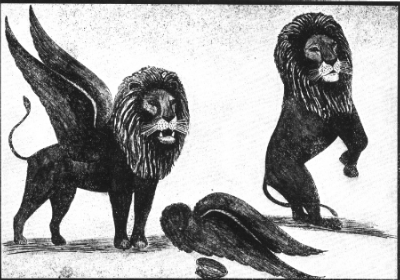
|
Shepherd's Rod book, Vol. 2 43, 44
handwriting on the wall: "This is the interpretation of the thing: Mene; God hath numbered thy kingdom, and finished it." (Dan. 5:26.) Therefore, Babylon fell into the hands of the Medo-Persian kings. Thus his wings "were plucked," and the Medo-Persian empire, number three, succeeded the lion, number two. Man’s Heart Given to It
After the wings of the lion were plucked, says Daniel: "He was made to stand upon his feet as a man, and a man's heart was given to it." Whatever is meant by the position of the beast and the exchange of heart, its application is after Babylon had fallen under Medo-Persian rule, for he stood as a man after the wings "were plucked." If we are to acquire the understanding of the symbol, we must first consider the function of the heart, for the symbol itself must be perfect, otherwise the truth cannot be determined.
The function of a heart is to preserve the life energy in the body. Let the heart stop and all is lost. This most vital organ is a governor of the body. As an empire is composed of numerous individuals, and their necessities, just so is the living body composed of a multitude of life cells, and all their essentials. As the duty of a king is to preserve the life energy in his kingdom, also punish or uproot the evil and to supervise the good, just so does the heart. By contraction and expansion it controls and imparts the flowing, living energy in the form of pure blood. The evidence gathered thus far Proves that the heart is a fitting symbol of a king. But we must specify the difference between the human and the beastly heart. Daniel 4:16, speaking of the penalty that was to fall upon the king before he was driven from his throne to the field with the beasts, says: "Let his heart be changed from a man's and let a beast's heart be given unto him; and let seven times pass over him." After the king's heart was changed, he lost his reason, and by nature became equal to an ox. "The same hour was the thing fulfilled upon Nebuchadnezzar: and he was driven from men, and did eat grass as an oxen and his body was wet with the dew of heaven, till his hairs were grown like eagles' feathers, and his nails like birds' claws." (Dan. 4:33.)
The human intellect does not consist in the external image of mankind, but it rather exists in the human heart. This thought is very emphatically entertained by the scriptures: "For out of the abundance of the heart the mouth speaketh." Therefore, the symbol (man's heart) may denote intelligence. However, the symbol cannot infer human vision, but rather a proper
Shepherd's Rod book, Vol. 2 45
understanding of God, for the Bible says: "The fool hath said in his heart, there is no God." (Psa. 53:1.) Obtaining a clear vision of the infinite power of the Eternal One is what God calls true education. The sum of the symbol is, Babylon was forced to acknowledge the existence of the Most High by removing one king (beast's heart) and setting up another (man's heart).
Having made clear what the symbol seems to indicate, we must take a brief survey of the ancient monarchy to see if this interpretation can be fully supported by the symbolical heart. As the everlasting example set forth by the flood for future generations had failed to teach the Chaldean rulers God's power and existence, the Creator of mankind in His mercy, patience and long suffering, not willing that any should perish, made a supreme effort to save that nation. "The Lord is not slack concerning His Promise, as some men count slackness; but is long suffering to us-ward, not willing that any should perish, but that all should come to repentance." (2 Peter 3:9.)
When the dream of the great image was given to Nebuchadnezzar his memory of the object was blotted out, but the impression left in his mind was greatly increased. After the urgent demand from the wise men had failed to reveal the king's dream, Daniel, by divine revelation, unmasked the mysterious phenomena by interpreting the dream. This wonderful miracle should have converted the king and all the wise men of Babylon to the Hebrew worship, for by the power of Daniel's God they had escaped the death penalty; but there was no change for the better. Though the king honored God with his lips, his heart drew away from Him. The king destroyed not the idols in the land, but in his blindness proceeded to set up superior ones; for shortly after the interpretation of the dream he demanded of all his subjects the worship of the "golden image" which he had set up in the plain of Dura. (Read the third chapter of Daniel.)
The refusal of the three Hebrews to bow down to the idol, and the miracle by which they were saved from the fiery furnace, had deeply affected the minds of the rulers, but it too, failed to change the king's heart. Again he honored the God of gods with his lips but not by his deeds. The king's ungodly deeds made it necessary for a supernatural penalty. Hence a tremendous effort to bring him to a realization of his dependence upon the Creator was necessary. The dream given him (in Daniel four), of the great tree -- a symbol of himself -- and its interpretation by Daniel, had convinced the hard-hearted monarch of its truth, and the judgment that was to fall upon him, except he repent. Daniel said: "Wherefore, O king, let my counsel be acceptable unto thee, and break off thy sins by righteousness,
Shepherd's Rod book, Vol. 2 46
and thine iniquities by shewing mercy to the poor; if it be a lengthening of thy tranquility.... At the end of twelve months he walked in the palace of the kingdom of Babylon.... The same hour was the thing fulfilled upon Nebuchadnezzar; and he was driven from men, and did eat grass as oxen, and his body was wet with the dew of heaven, till his hairs were grown like eagles' feathers, and his nails like birds' claws." (Dan. 4:27, 29, 33.)
At the end of the painful experience, the king said: "Now I Nebuchadnezzar praise and extol and honour the King of heaven, all whose works are truth, and His ways judgment: and those that walk in pride He is able to abase." (Dan. 4:37.) Though he acknowledged the power of the Eternal One, worshiped Him, and uttered words of praise with a most sublime expression, the king failed to surrender his heathen heart and renounce the pagan system of worship. He failed to embrace the great importance of imparting the knowledge of Jehovah to his posterity for the tranquility and endurance of his kingdom.
These wonderful experiences were for an object lesson to future kings. Shortly after the fulfillment of the dream, the kings' grandson had ascended the throne. In his heathen custom he ventured to defy the God of gods, and the King of kings, who is able to make oxen out of kings and kings out of oxen, and rulers out of slaves. "For promotion cometh neither from the east, nor from the west, nor the south. But God is the judge: He putteth down one, and setteth up another." (Psa. 75:6, 7.)
The sacred vessels had never before been defiled by any king as in Belshazzar's drunken feast. God will forbear until man steps over the boundary line. This Belshazzar did by bringing the sacred vessels before his lords, concubines, and heathen gods. At the appearance of the hand writing on the wall his guilty conscience troubled him; his loins were loosed, and his knees smote one against the other. Belshazzar, like his father, ignored Daniel and summoned the wise men of Babylon to interpret the writing; though he should have known their inability to reveal the secret. At last Daniel was called and at his appearance he said: "This is the interpretation of the thing: Mene; God hath numbered thy kingdom, and finished it. Tekel; Thou art weighed in the balances, and art found wanting. Peres; Thy kingdom is divided, and given to the Medes and Persians." (Dan. 5:26-28.) The priceless experiences of his father that were at his access could have been everlasting blessings, but by ignoring the power of God the king reversed the benefits from a blessing to a curse, and brought a final end to his kingdom. Every resource to make the lion (Babylon) stand up like a man under the rule of the Chaldean kings had been exhausted, and every effort failed.
Shepherd's Rod book, Vol. 2 47
Therefore, the time had come for the Lord to apply the last remedy to the lion kingdom.
Cyrus, of whom God had spoken by His prophet many years in advance, was granted to enter the capital city of the Chaldean king. (See Isa. 45:1.) Babylon as empire number two passed away, and the symbol of the "plucked" wings met its fulfillment. "In that night was Belshazzar the king of the Chaldean's slain." The lion's heart is a symbol of the heathen king -- Belshazzar who was slain -- and thus the beastly heart was removed. Man proposes, but oftentimes another power over which he has no control, disposes.
Daniel was made first president over the 120 princes because an "excellent spirit was found in him." Both Cyrus and Darius were converted to the worship of the true God. Therefore, the everlasting Arm which intervenes in the affairs of mankind, set up a king of His own choice.
In this manner the symbols met their fulfillment and the lion "was lifted up from the earth, and made to stand upon the feet as a man, and a man's heart was given to it."
The heart is a fitting emblem of a ruler of a nation. The contrast between a godly and an ungodly king is as vastly different as between the human and the beastly heart. The heart is the life-giving energy to the human body, just as a king is the head of a nation.
After freedom had been granted to the Jews, Cyrus, in his proclamation said: "Thus saith Cyrus king of Persia, The Lord God of heaven hath given me all the kingdoms of the earth; and He hath charged me to build him an house at Jerusalem, which is in Judah. Who is there among you of all His people? His God be with him, and let him go up to Jerusalem, which is in Judah, and build the house of the Lord God of Israel, (He is the God,) which is in Jerusalem." (Ezra 1:2, 3.) This godly influence of the kings of Medo-Persia did not wear out until years later. The decree made by Cyrus was written in a roll and placed at Achmetha, in the palace that is in the province of the Medes. Years later the roll being found by Darius, the edict was immediately carried out. Cyrus had decreed that all should make a free will offering, and the king himself contributed without limit. He said: "Moreover I make a decree what ye shall do to the elders of these Jews for the building of this house of God: that of the king's goods, even of the tribute beyond the river, forthwith expenses to be given to these men, that they be not hindered." (Ezra 6:8.) He further decreed that all the needs to maintain the sacrificial services "be given them day by day without fail." Then he added "That they may offer sacrifices
Shepherd's Rod book, Vol. 2 48
of sweet savours unto the God of heaven, and pray for the life of the king, and of his sons." (Ezra 6:10.) Nebuchadnezzar professed conversion after his wonderful experience with the God of heaven, and declared: "And all the inhabitants of the earth are reputed as nothing: and He doeth according to His will in the army of heaven, and among the inhabitants of the earth: and none can stay His hand, or say unto Him, What doest thou? At the same time my reason returned unto me; and for the glory of my kingdom, mine honor and brightness returned unto me, and my counsellors and my lords sought unto me; and I was established in my kingdom, and excellent majesty was added unto me. Now I Nebuchadnezzar praise and extol and honour the King of heaven, all whose works are truth, and His way judgment: and those that walk in pride He is able to abase." (Dan. 4:35-37.)
Though the sublime words spoken by the Chaldean king seems to reveal a change of heart, his works showed failure in what his lips proclaimed. What a contrast between the Babylonian monarch, and the Medo-Persian kings! Nebuchadnezzar declined to set God's people free, he refused to restore the sacred vessel to the King of heaven; he made no decree for the rebuilding of the house of God; he gave no gift of any kind to the King of kings; he imparted not the knowledge of Jehovah to his people; he left his children and his household to worship the heathen gods of wood and stone; he made no effort to give God the glory, save with his lips.
Though we have these living examples before us, yet how often we admit by our lips that which is right and true, and make no move to reach for the stretched out Arm of divine love. Multitudes are aping the standard set by the ancient monarch. "This people draweth nigh unto me with their mouth, and honoureth me with their lips; but their heart is far from me." (Matt. 15:8.)
Though Nebuchadnezzar failed in these sacred things, God, in His great mercy saved the King. God bore long with the Babylonian king, but "the once proud monarch had become a humble child of God; the tyrannical, overbearing ruler, a wise and compassionate king. He who had defied and blasphemed the God of heaven, now acknowledged the power of the Most High, and earnestly sought to promote the fear of Jehovah and the happiness of his subjects. Under the rebuke of Him who is King of kings and Lord of lords, Nebuchadnezzar had learned at last the lesson which all rulers need to learn." -- "Prophets and Kings," p. 521.
Shepherd's Rod book, Vol. 2 49